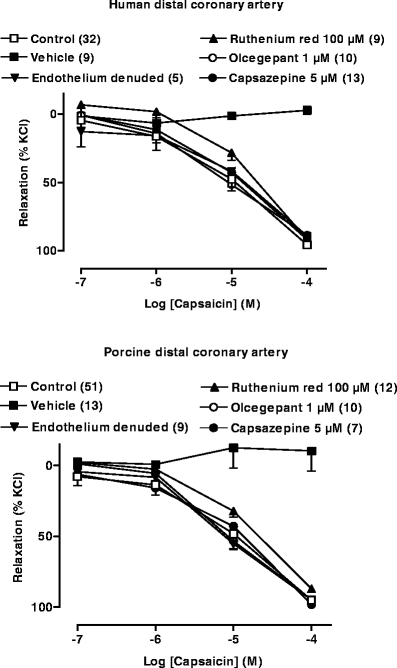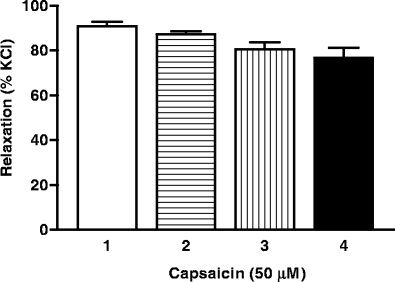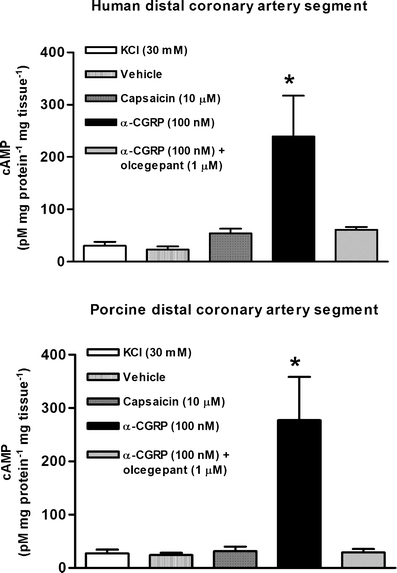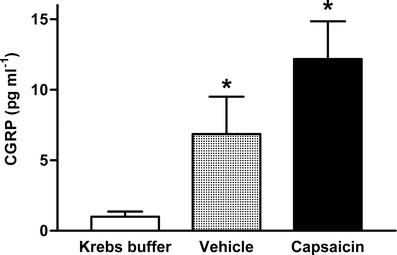Pharmacological characterisation of capsaicin-induced relaxations in human and porcine isolated arteries
- PMID: 17295025
- PMCID: PMC1915621
- DOI: 10.1007/s00210-007-0137-y
Pharmacological characterisation of capsaicin-induced relaxations in human and porcine isolated arteries
Abstract
Capsaicin, a pungent constituent from red chilli peppers, activates sensory nerve fibres via transient receptor potential vanilloid receptors type 1 (TRPV1) to release neuropeptides like calcitonin gene-related peptide (CGRP) and substance P. Capsaicin-sensitive nerves are widely distributed in human and porcine vasculature. In this study, we examined the mechanism of capsaicin-induced relaxations, with special emphasis on the role of CGRP, using various pharmacological tools. Segments of human and porcine proximal and distal coronary arteries, as well as cranial arteries, were mounted in organ baths. Concentration response curves to capsaicin were constructed in the absence or presence of the CGRP receptor antagonist olcegepant (BIBN4096BS, 1 microM), the neurokinin NK1 receptor antagonist L-733060 (0.5 microM), the voltage-sensitive calcium channel blocker ruthenium red (100 microM), the TRPV1 receptor antagonist capsazepine (5 microM), the nitric oxide synthetase inhibitor Nomega-nitro-L-arginine methyl ester HCl (L-NAME; 100 microM), the gap junction blocker 18alpha-glycyrrhetinic acid (10 microM), as well as the RhoA kinase inhibitor Y-27632 (1 microM). Further, we also used the K+ channel inhibitors 4-aminopyridine (1 mM), charybdotoxin (0.5 microM) + apamin (0.1 microM) and iberiotoxin (0.5 microM) + apamin (0.1 microM). The role of the endothelium was assessed by endothelial denudation in distal coronary artery segments. In distal coronary artery segments, we also measured levels of cyclic adenosine monophosphate (cAMP) after exposure to capsaicin, and in human segments, we also assessed the amount of CGRP released in the organ bath fluid after exposure to capsaicin. Capsaicin evoked concentration-dependent relaxant responses in precontracted arteries, but none of the above-mentioned inhibitors did affect these relaxations. There was no increase in the cAMP levels after exposure to capsaicin, unlike after (exogenously administered) alpha-CGRP. Interestingly, there were significant increases in CGRP levels after exposure to vehicle (ethanol) as well as capsaicin, although this did not induce relaxant responses. In conclusion, the capsaicin-induced relaxations of the human and porcine distal coronary arteries are not mediated by CGRP, NK1, NO, vanilloid receptors, voltage-sensitive calcium channels, K+ channels or cAMP-mediated mechanisms. Therefore, these relaxant responses to capsaicin are likely to be attributed to a non-specific, CGRP-independent mechanism.
Figures




References
-
- {'text': '', 'ref_index': 1, 'ids': [{'type': 'DOI', 'value': '10.1038/sj.bjp.0705486', 'is_inner': False, 'url': 'https://doi.org/10.1038/sj.bjp.0705486'}, {'type': 'PMC', 'value': 'PMC1574074', 'is_inner': False, 'url': 'https://pmc.ncbi.nlm.nih.gov/articles/PMC1574074/'}, {'type': 'PubMed', 'value': '14534154', 'is_inner': True, 'url': 'https://pubmed.ncbi.nlm.nih.gov/14534154/'}]}
- Akerman S, Kaube H, Goadsby PJ (2003) Vanilloid type 1 receptors (VR1) on trigeminal sensory nerve fibres play a minor role in neurogenic dural vasodilatation, and are involved in capsaicin-induced dural dilation. Br J Pharmacol 140:718–724 - PMC - PubMed
-
- {'text': '', 'ref_index': 1, 'ids': [{'type': 'DOI', 'value': '10.1111/j.1468-2982.2004.00743.x', 'is_inner': False, 'url': 'https://doi.org/10.1111/j.1468-2982.2004.00743.x'}, {'type': 'PubMed', 'value': '15315527', 'is_inner': True, 'url': 'https://pubmed.ncbi.nlm.nih.gov/15315527/'}]}
- Arulmani U, Heiligers JPC, Garrelds IM, Sánchez-López A, Willems EW, Villalón CM, Saxena PR (2004a) Effects of sumatriptan on capsaicin-induced carotid haemodynamic changes and CGRP release in anaesthetized pigs. Cephalalgia 24:717–727 - PubMed
-
- {'text': '', 'ref_index': 1, 'ids': [{'type': 'DOI', 'value': '10.1016/j.ejphar.2004.07.035', 'is_inner': False, 'url': 'https://doi.org/10.1016/j.ejphar.2004.07.035'}, {'type': 'PubMed', 'value': '15464043', 'is_inner': True, 'url': 'https://pubmed.ncbi.nlm.nih.gov/15464043/'}]}
- Arulmani U, MaassenVanDenBrink A, Villalón CM, Saxena PR (2004b) Calcitonin gene-related peptide and its role in migraine pathophysiology. Eur J Pharmacol 500:315–330 - PubMed
-
- {'text': '', 'ref_index': 1, 'ids': [{'type': 'DOI', 'value': '10.1111/j.1468-2982.2005.01082.x', 'is_inner': False, 'url': 'https://doi.org/10.1111/j.1468-2982.2005.01082.x'}, {'type': 'PubMed', 'value': '16686903', 'is_inner': True, 'url': 'https://pubmed.ncbi.nlm.nih.gov/16686903/'}]}
- Arulmani U, Gupta S, MaassenVanDenBrink A, Centurión D, Villalón CM, Saxena PR (2006) Experimental migraine models and their relevance in migraine therapy. Cephalalgia 26:642–659 - PubMed
-
- {'text': '', 'ref_index': 1, 'ids': [{'type': 'DOI', 'value': '10.1161/01.CIR.0000128696.12245.57', 'is_inner': False, 'url': 'https://doi.org/10.1161/01.cir.0000128696.12245.57'}, {'type': 'PubMed', 'value': '15117835', 'is_inner': True, 'url': 'https://pubmed.ncbi.nlm.nih.gov/15117835/'}]}
- Batenburg WW, Garrelds IM, Bernasconi CC, Juillerat-Jeanneret L, van Kats JP, Saxena PR, Danser AHJ (2004a) Angiotensin II type 2 receptor-mediated vasodilation in human coronary microarteries. Circulation 109:2296–2301 - PubMed
MeSH terms
Substances
LinkOut - more resources
Full Text Sources
Research Materials
Miscellaneous

